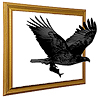The dart frogs are a well-known group of beautiful and tiny diurnal amphibians found throughout the American tropics. In addition to producing complex alkaloid skin sec- retions, this group is remarkable in ex- hibiting astonishing parental care within its ranks. The Central American species Oophaga pumilio deposits several eggs on a leaf on the forest floor, which are guarded by the male. Upon hatching, the tadpoles wriggle onto the female’s back, and are taxied up the trunk of a tree to a pre- selected bromeliad, where they are deposited into one of the water vessels formed within the axils of these arboreal epiphytes. Every few days, the female lays an unfertilized egg for each of her offspring to feed upon.
Incidental species in this painting include an Agouti (Dasyprocta punctata), a Spec- tacled Antpitta (Hylopezus perspicallitus), a Racerunner (Ameiva festiva), a Lantern- bug (Fulgora laternaria), a Leaf-Footed Bug (Anisosceles sp.), a leaf- hopper (Umbonia sp.), a Consul Butterfly (Consul fabius), and numerous ants of the species Pheidole bicornis, which are dependent on the leaves of Piper trees, like the one immediately behind the frog.
 Science Art-Nature .presents:
Science Art-Nature .presents:
 Science Art-Nature .presents:
Science Art-Nature .presents: